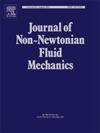s型流变流体泊泽维尔流的数值模拟:顺流带和粘性沙漏
IF 2.7
2区 工程技术
Q2 MECHANICS
引用次数: 0
摘要
最近关于玉米淀粉在圆柱形管中压力驱动的泊泽维尔流动的实验(Talon和Salin, 2024)显示了令人惊讶的行为。测量到的流量曲线,即流量与施加压降的关系,确实是非单调的:在低压下,流量单调增加,直到达到最大值,然后,无论压降进一步增加,流量都突然下降到几乎恒定的流量。已知玉米淀粉具有不连续剪切增稠(DST)行为(Fall et al., 2012)。此外,最近的实验(Denn et al., 2018;Darbois Texier et al., 2020;Bougouin et al., 2024)认为流变最终可能是s形的,剪切速率是应力的非单调函数,类似于Wyart and Cates提出的模型(Wyart and Cates, 2014)。为了解释所观察到的流量跳台行为,一种可能性是s形流变的泊泽维尔流表现出某种相分离,其中压力梯度变得不均匀。压力梯度在高压力梯度和低压力梯度两种类型的区域之间分离。Talon和Salin(2024)使用润滑近似并假设非单调s形流变wyart - gates模型的简单动态随机版本分析了这种“流向带状”。当压力增加时,平台特性与高粘性区域的增加有关。即使悬浮液保持均匀,非单调流变曲线的存在也足以预测沿流方向出现带状。在本文中,我们的目的是通过不考虑润滑近似,直接求解具有s型流变的剪切增稠流体的流动来分析这一预测。利用二维TRT晶格玻尔兹曼模拟,我们观察到流量的平台确实与压力梯度的顺流分离有关。此外,我们还表明,高压梯度区域是由于形成了类似于“沙漏”形状的高粘性结构。然后,我们分析了这些沙漏结构作为系统参数的函数。本文章由计算机程序翻译,如有差异,请以英文原文为准。
Numerical simulation of Poiseuille flow for S-shaped rheology fluid: Streamwise banding and viscous sandglasses
Recent experiments on pressure-driven Poiseuille flow of cornstarch in a cylindrical tube (Talon and Salin, 2024) show a surprising behavior. The measured flow curve, i.e. the flow rate versus the applied pressure drop, is indeed non-monotonic: the flow rate increases monotonically at low pressure drops up to a maximum, after which it decreases abruptly to an almost constant flow rate regardless of further increases in pressure drop. Cornstarch is known to exhibit discontinuous shear thickening (DST) behavior (Fall et al., 2012). In addition, recent experiments (Denn et al., 2018; Darbois Texier et al., 2020; Bougouin et al., 2024) suggest that the rheology may ultimately be S-shaped, where the shear rate is a nonmonotonic function of stress, similar to the model proposed by Wyart and Cates (Wyart and Cates, 2014). To account for the observed jump-plateau behavior of the flow rate, one possibility is that Poiseuille flow for S-shaped rheology exhibits some kind of phase segregation, where the pressure gradient becomes non-uniform. The pressure gradient segregate between two types of region, with either high pressure gradient or low one. This kind of “streamwise banding” were analyzed in Talon and Salin (2024) using the lubrication approximation and assuming simple dynamical stochastic version of the nonmonotonic S-shaped rheology Wyart–Cates model. The plateau behavior is then related to an increase of the high viscous region as the pressure is increased. The mere presence of a non-monotonic rheological curve could then be sufficient to predict the occurrence of banding in the streamwise direction, even if the suspension remains homogeneous.
In this paper, we aim to analyze this prediction by disregarding the lubrication approximation and directly solving the flow of a shear thickening fluid with S-shaped rheology. Using 2D TRT Lattice Boltzmann simulations, we observe that the plateau in flow rate is indeed associated with a streamwise segregation of the pressure gradient. In addition, we show that regions of high pressure gradients are due to the formation of a highly viscous structure similar to a “sandglass” shape. We then analyze the occurrence of these sandglass structures as a function of the system parameters.
求助全文
通过发布文献求助,成功后即可免费获取论文全文。
去求助
来源期刊
CiteScore
5.00
自引率
19.40%
发文量
109
审稿时长
61 days
期刊介绍:
The Journal of Non-Newtonian Fluid Mechanics publishes research on flowing soft matter systems. Submissions in all areas of flowing complex fluids are welcomed, including polymer melts and solutions, suspensions, colloids, surfactant solutions, biological fluids, gels, liquid crystals and granular materials. Flow problems relevant to microfluidics, lab-on-a-chip, nanofluidics, biological flows, geophysical flows, industrial processes and other applications are of interest.
Subjects considered suitable for the journal include the following (not necessarily in order of importance):
Theoretical, computational and experimental studies of naturally or technologically relevant flow problems where the non-Newtonian nature of the fluid is important in determining the character of the flow. We seek in particular studies that lend mechanistic insight into flow behavior in complex fluids or highlight flow phenomena unique to complex fluids. Examples include
Instabilities, unsteady and turbulent or chaotic flow characteristics in non-Newtonian fluids,
Multiphase flows involving complex fluids,
Problems involving transport phenomena such as heat and mass transfer and mixing, to the extent that the non-Newtonian flow behavior is central to the transport phenomena,
Novel flow situations that suggest the need for further theoretical study,
Practical situations of flow that are in need of systematic theoretical and experimental research. Such issues and developments commonly arise, for example, in the polymer processing, petroleum, pharmaceutical, biomedical and consumer product industries.

 求助内容:
求助内容: 应助结果提醒方式:
应助结果提醒方式:


